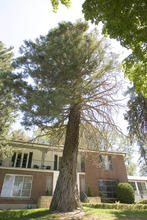This is an archived article that was published on sltrib.com in 2012, and information in the article may be outdated. It is provided only for personal research purposes and may not be reprinted.
When Maxine C. and Whitney J. Haight planted a small redwood sapling in their yard 54 years ago, they figured it might have trouble growing in Utah.
Little did they know how tough that tiny tree would prove to be.
Despite Utah's merry-go-round of snow, dryness and heat, the tree sprouted about 75 feet skyward. Its reddish-brown barrel of a trunk swelled to about 3 or 4 feet wide.
"It's shot up like a rocket," said Holly Mirabelli, 59, Whitney and Maxine Haight's daughter who grew up in the Millcreek area home.
It's a tree that three generations of the family said goodbye to this week. Despite their most ardent efforts — which included consultations with arborists, deep-root fertilizationand lots of love and care — they couldn't save the tree, which they believe is dying because of root damage caused by sewer work on the street several years ago.
"It's been a sad topic, losing the tree," said Whitney and Maxine Haight's granddaughter Emily Mirabelli, 30, in a somber tone. The family, however, knows that though the tree may be gone, their memories of what it meant to them remain firmly planted.
The family story is that the sapling was purchased in California by a colleague of Whitney Haight, who gave it to him as a gift.Whitney Haight, who passed away in 2010 at age 92, was well-known in Salt Lake City as an ear, nose and throat doctor, whose practice with his father-in-law, at one point, was on the top floors of the Boston Building downtown.
Whitney Haight had a reputation, his family says, for never turning away a patient. He treated many immigrants who paid him in everything from bottles of whiskey to pastries to glassware, his grandson Alex Mirabelli, 25, said. Patients sometimes waited in his office all day, packing lunches, knowing that he would help them.
Less well-known were Whitney Haight's hobbies.He wasn't one to pay someone to do something he could do himself. He was an avid machinist, building model steam engines in his basement. He crafted much of the wrought iron that still adorns the Millcreek home. And he loved plants and trees, especially unusual ones.
"My grandfather was so good at growing everything," his granddaughter said. "He was a marvelous gardener." Melons and tobacco were also among the crops Whitney Haight grew on the property. Just 10 days before he died, he mowed his lawn.
Planting trees was also important to Maxine Haight, who spent much of her childhood in the town of Dividend, Utah, where her father was the physician for the Tintic Standard Mining Company. Dividend, now a ghost town, was a largely treeless, arid place.
"Having lived in Dividend, where there were no trees, we missed the trees," said Maxine Haight, now 94, of her childhood there.
So when Whitney and Maxine Haight moved to their Millcreek home in the early 1950s, they got to work, filling their front and backyards with maples, junipers, oaks, evergreens and other trees, including the redwood. When they first moved in, the landscape was almost barren. At the time, Millcreek was considered the outskirts of town.
Now, a veritable canopy of tall treetops shades the Haights' neighborhood, including their own redwood, which far surpassed their expectations.
Bill Rutherford, Salt Lake City forester, said the tree is likely a Sequoiadendron giganteum, better known as a Sierra redwood. It's a tree that's characteristic of Southern California, where under the right conditions, it can live for thousands of years. The Sierra redwood doesn't grow as tall as the coast redwood of Northern California, he said, but it can reach a height of up to 200 feet. The tree's trunk, under the right conditions, can grow so large as to stretch from curb to curb of a downtown street.
Rutherford said he's probably seen a few dozen Sierra redwoods in Salt Lake City over the years. They don't tend to grow as big here as they might in California, given Salt Lake City's lower humidity, soil with higher pH levels and weather patterns.
But he called it an unusual and special tree.
Though the family won't be able to enjoy the tree anymore in their yard, they plan to make sure it lives on in other ways. This week, the tree was cut down and milled at the house, and the family plans to use the lumber on projects and keepsakes.
"Being of the Depression era and World War II, my grandparents never got rid of anything," Alex Mirabelli said.
"He would not like the idea of just throwing it away," Emily Mirabelli added of her grandfather.
On a recent day, shortly before the family cut down the tree, Emily Mirabelli told her grandmother that they would make something for her out of wood from the tree.
Maxine Haight asked what that might be.
Anything she wanted, her granddaughter answered.
Twitter: @lschencker







